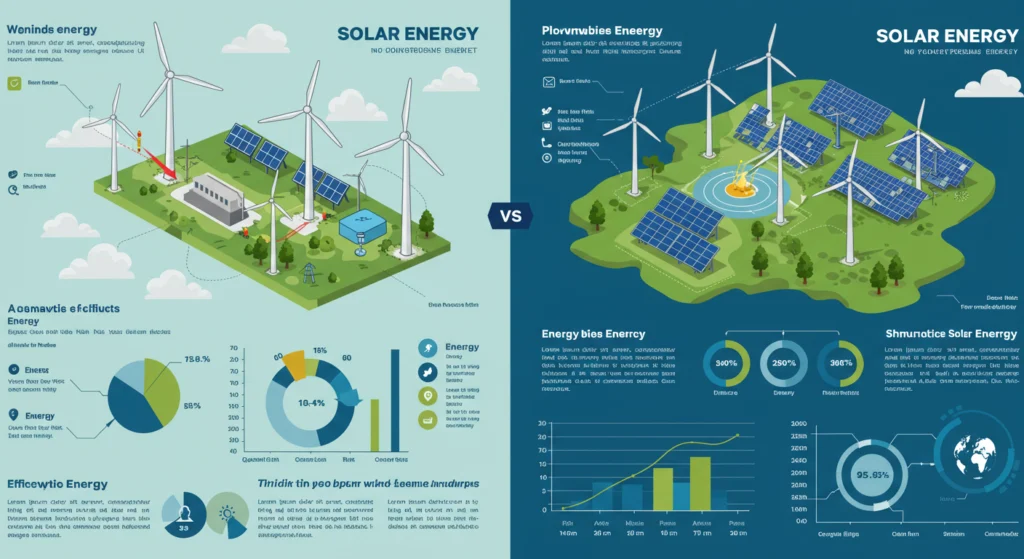Wind Energy vs. Solar Energy: Which Is More Efficient?
The global shift towards renewable energy sources is undeniable, driven by environmental concerns and the finite nature of fossil fuels. Among the frontrunners in this green revolution are **wind energy** and **solar energy**, both offering promising alternatives for power generation. But when it comes to harnessing nature’s power, a crucial question arises: **Wind energy vs. solar energy: which is more efficient?** This in-depth guide will delve into the intricacies of both technologies, comparing their efficiency, environmental impact, cost-effectiveness, and suitability for various applications, helping you understand which might be the better choice for a sustainable future.
—
Understanding Efficiency in Renewable Energy
Before we directly compare wind and solar, it’s essential to define what “efficiency” means in the context of renewable energy. It’s not just about how much energy a system produces, but also about how effectively it converts available resources into usable electricity. Key metrics include:
- Capacity Factor: This represents the actual output of a power plant over a period of time, divided by its maximum potential output. A higher capacity factor indicates more consistent energy production.
- Energy Conversion Efficiency: This refers to how well a system converts the raw energy source (wind or sunlight) into electricity.
- Land Use Efficiency: How much power can be generated per unit of land area.
—
Wind Energy: Harnessing the Invisible Current
Wind energy relies on the kinetic energy of moving air to spin turbine blades, which in turn drive a generator to produce electricity. It’s a technology that has seen significant advancements in recent decades, with turbines becoming larger and more powerful.
How Wind Turbines Generate Power
Modern wind turbines are sophisticated machines designed to capture wind energy efficiently. The blades are aerodynamically designed to maximize lift and minimize drag, much like an airplane wing. When the wind blows, it creates pressure differences across the blades, causing them to rotate. This rotational energy is then transferred through a gearbox to a generator, converting mechanical energy into electrical energy.
Efficiency of Wind Energy
Wind power boasts a relatively high capacity factor compared to some other renewables. Large onshore wind farms can achieve capacity factors ranging from 35% to 45%, while offshore wind farms, benefiting from more consistent and stronger winds, can often exceed 50%, sometimes even reaching 60% in optimal locations. The energy conversion efficiency of a wind turbine typically ranges from 30% to 50%, meaning that 30% to 50% of the wind’s kinetic energy is converted into electricity. The availability of wind, however, is intermittent, meaning power generation fluctuates with wind speed.
—
Solar Energy: Capturing the Sun’s Radiance
Solar energy, primarily harnessed through photovoltaic (PV) panels, converts sunlight directly into electricity. This technology has become increasingly popular for both residential and commercial applications due to decreasing costs and improving efficiency.
How Solar Panels Generate Power
Solar panels are made up of photovoltaic cells, typically composed of silicon. When sunlight (photons) strikes these cells, it excites electrons, creating an electric current. This direct current (DC) is then converted into alternating current (AC) by an inverter, making it suitable for use in homes and businesses or for feeding into the grid.
Efficiency of Solar Energy
The efficiency of solar panels has steadily improved over the years. Standard commercial solar panels typically have an energy conversion efficiency of 17% to 20%, though high-end panels can reach 22% or even higher in laboratory settings. The capacity factor for solar power plants is generally lower than wind, typically ranging from 15% to 25%, as it is entirely dependent on daylight hours and weather conditions. Factors like cloud cover, shading, and even the angle of the sun can significantly impact output.
—
Direct Comparison: Wind Energy vs. Solar Energy Efficiency
Now, let’s put them head-to-head on key efficiency metrics:
Capacity Factor: Wind Takes the Lead
In terms of consistent power output, wind energy generally has a higher capacity factor. This is because wind can blow at night and often more consistently over longer periods, especially in optimal locations. Solar, by its nature, only produces electricity during daylight hours.
Energy Conversion: A Closer Race
While wind turbines can achieve higher conversion rates of kinetic energy to electricity, solar panel efficiency has made remarkable strides. The raw resource (sunlight vs. wind) also plays a role in how “efficiently” it can be captured.
Land Use: Solar Can Be More Flexible
Large-scale wind farms require significant land area, not just for the turbines themselves but also for spacing to minimize turbulence and maximize wind capture. Solar farms, while also requiring land, can often be more compactly arranged. Furthermore, solar panels can be integrated into existing structures, such as rooftops, maximizing urban space efficiency, which is something wind turbines generally cannot do.
Intermittency and Storage: Challenges for Both
Both wind and solar energy are intermittent sources, meaning their output fluctuates. When the wind doesn’t blow or the sun doesn’t shine, power generation drops. This necessitates robust energy storage solutions (like batteries) or a diverse energy mix to ensure a reliable power supply. However, the predictability of solar (it will always be sunny during the day, barring extreme weather) can sometimes make its intermittency more manageable than wind, which can be less predictable in its hourly variations.
—
Environmental Impact and Other Considerations
Beyond pure efficiency, other factors influence the overall viability and desirability of wind and solar power:
Environmental Footprint
- Wind: Concerns include visual impact, noise pollution, and potential impact on bird and bat populations (though advancements in technology and siting strategies are mitigating these).
- Solar: Production of solar panels involves some hazardous materials, but the operational phase is very clean. Land use for large solar farms can impact ecosystems.
Cost-Effectiveness
Both technologies have seen significant cost reductions in recent years. Solar panel costs have plummeted, making rooftop solar increasingly affordable. Wind power, especially large-scale projects, remains highly competitive, often offering some of the lowest Levelized Cost of Electricity (LCOE) among new power generation sources. The ongoing research and development in both fields continue to drive down costs.
Scalability and Application
Both wind and solar are highly scalable. Solar is excellent for distributed generation (rooftop installations) as well as large utility-scale projects. Wind is typically more suited for utility-scale power generation, though small residential wind turbines exist. The choice often depends on geographic location, available space, and specific energy needs.
—
When considering **wind energy vs. solar energy: which is more efficient?**, there’s no single definitive answer. Both renewable sources have distinct advantages and disadvantages regarding efficiency, environmental impact, and cost. Wind power often boasts a higher capacity factor and can generate electricity more consistently over 24 hours in ideal locations, making it a strong contender for large-scale grid contributions. Solar power, while having a lower capacity factor due to its reliance on daylight, offers incredible flexibility for decentralized generation and has seen remarkable advancements in panel efficiency and cost reduction. Ultimately, the most effective approach to a sustainable energy future will likely involve a complementary mix of both wind and solar power, alongside other renewables, to ensure a reliable, diverse, and clean energy supply. The continued innovation in both sectors promises an even more efficient and sustainable tomorrow.



